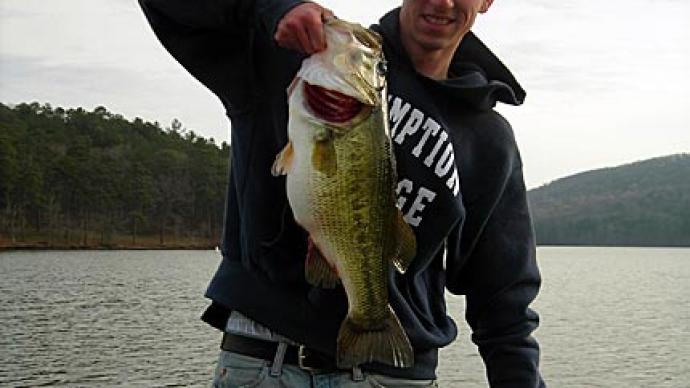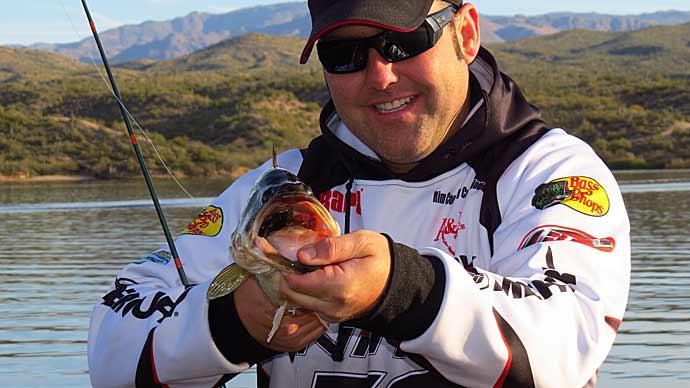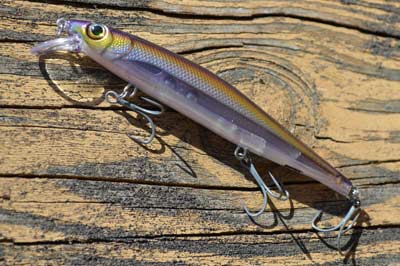
Early spring weather is typically volatile. One week — sometimes one day — you’re basking in the sun, leaving your jacket and gloves at home. But the next, you need to muster all the clothes you can while dodging snowflakes.
That scenario was restricted to the bass range's southernmost stretches not long ago. But fluctuations in when winter arrives and how long it stays have given more anglers more time to chase bass. In many places, ice fishing gear is being traded for lures that catch bass, especially during early prespawn.
Prespawn season starts when bass first leave their winter haunts. It continues until water temperatures pass 70 degrees and most bass are done spawning—the stretch trends toward warmer weather, water temperatures and fishing expectations. As the days tick by, your lures should offer more and more action. But not always.
Early spring bass are sensitive to their conditions. While a stretch of sunny skies and warm temperatures motivate them to eat and move, a passing cold front or return to wintery weather does the opposite. Those changes can happen over the course of a single day.
Versatile anglers shine this time of year. Not only do they switch locations as conditions change, but they come to the lake prepared with lures that produce under various depths, speeds, and combinations of cover and structure. These five are those types of lures.
Jerkbait
Regardless of the season, you need to find bass before you can catch them. This versatile three-hooked springtime classic does better than most other lures, thanks to its speedy slashing stop-and-go action.
- Examples: Megabass Ito Vision 110, Smithwick Rattlin’ Rogue, Rapala PXR Mavrik 110
- Size: 4 inches to 5 inches
- Top colors: Baitfish patterns, especially translucent or chrome with black or blue back; pearl with orange belly; clown
Thanks to various colors, sizes, and diving depths, jerkbaits are versatile in spades. But their ability to float, suspend, or sink on the pause is significant. A floating one, for example, is great when bass are active. Its forward movement may stop but shimmers as it rises, keeping a following bass interested. On the other hand, one that slowly sinks when paused will settle into a sluggish bass's face, creating a reaction strike. And the suspender, which sits motionless in the water column, works best when conditions fall in between.
Jerkbait retrieves are straightforward. They're a mix of twitches and pauses, the correct combination of what bass prefer on a given day. As bass activity increases, twitches should increase in number and speed, and pauses should decrease. And while they're at home in almost any spot, these three are some of the best during early prespawn:
- Flats: These hold plenty of early prespawn bass regardless of their depth. Search out the sweet spots, such as a creek channel, or pieces of isolated cover, such as boulders or submerged aquatic vegetation.
- Windblown shoreline: Early-season bass eat many baitfish, congregating wherever their microscopic meals are blown. The best stretches are close to wintering holes.
- Shallow-protected pockets: Bass will slide into these on sunny days, taking advantage of slightly warmer water. Focus your casts around the mouths, especially if boat docks are present.
Final tip: Matching your retrieve cadence to the bass’ current mood is essential, but so is minding the slack in your line. Move your rod tip a couple of inches toward your jerkbait on the pause, giving it the freedom it needs, but not so much that you lose contact and miss a subtle strike.
Jig
These bottom-bouncers are productive any time of year, but prespawn’s relatively cold water is one of the best. Use them to pick apart the cover that bass cling to, from deep to shallow water.
- Examples: Dirty Jigs Luke Clauson Compact Pitchin’ jig, Greenfish Tackle Brandon Cobb All Purpose Jig, Keitech Tungsten Casting Jig
- Best sizes: 3/8 ounce to 1 ounce
- Top colors: Black, green pumpkin, brown and orange
Leave your flipping stick at home until you get to the prespawn’s end and bass are holed up in thick shallow cover. Instead, choose a rod that measures 7 feet, maybe a few inches more, that comfortably generates long pitches and accurate casts. Its fast action will bring casting accuracy, and its heavy power will slam home hook sets and turn big prespawn bass toward your boat. Any speedy reel will work; fill its spool with 15- to 20-pound test fluorocarbon or 50-pound test braided line.
Slide your jig along the bottom instead of hopping it. While it'll work in nearly any combination of structure, cover, and depth, these are the best places during early prespawn:
- Rocky breaks: Whether along the bank, a point, or a creek channel, these are prespawn hotspots. Their resident crawfish are a bass’ favorite meal and what a dark-colored jig imitates best.
- Boat docks: Fish these slowly, concentrating on their vertical pilings and any associated rock or cement. Bass often tuck against the bottom, so make sure that’s where you’re fishing your jig.
- Shallow wood: Bass use wood cover throughout prespawn. Like rock, it absorbs solar energy, releasing it as heat into the surrounding water. Focus on the deepest stretches early in the season.
Final tip: Don’t fall into the rhythm of fishing your jig too slow, even in the coldest water. While it might help to let it soak in one spot, allowing its skirt and trailer to wave enticingly, only work your jig through the best stretches of each cast or pitch. Send it out, work it through the prime spot, retrieve it, and then repeat.
Lipless Crankbait
Don’t be fooled by this lure’s simplistic cast-and-crank nature. They can be fished at various locations, depths, and speeds, making them perfect for finding, catching, and keeping up with prespawn bass.
- Examples: Original Rat-L-Trap, Strike King Red Eye Shad, Booyah One Knocker
- Best sizes: ¼ ounce or ½ ounce
- Top colors: Shad, chrome with blue or black back, chartreuse crawfish
These sinking crankbaits are a reaction-strike generator, an important approach to getting bites from bass stunned by cold water or passing fronts. Stick to compact versions — ½ ounce or less — which are easy to cast. Their internal rattles create plenty of noise, drawing bass from a distance or heavy cover.
As with jerkbaits, you need to find the proper retrieve cadence for lipless crankbaits. Some days, a slow, steady retrieve will score. But more often than not, you'll want one punctuated with pauses, either by stopping your retrieve or pulling the lure forward with your rod and then letting it fall.
Whether loners or schoolies, bass rarely pass up a lipless crankbait. So, keep casting one, regardless of what you come across. But make a few more casts on these spots:
- Submerged aquatic vegetation: A pull-and-drop retrieve works best here. Add reaction-strike appeal by allowing your lure to sink into the grass and then ripping it free by using braided line.
- Shallow pockets: Prespawn bass are on the move, usually under low-light conditions such as rainy or overcast days. Fan cast the mouths of these spots, where bass will eventually spawn.
- Secondary points: Stopover spots from wintering holes to spawning flats, which are replenished regularly. Lipless crankbaits let you know if any bass are home in quick order.
Final tip: Speed and sound make lipless crankbaits attractive to bass. But that doesn't mean you should shortcut your color choice. Instead of matching the hatch, cater to the conditions. Flashy offerings, such as chrome with a blue back, work in clear water, where bass primarily feed with their eyesight.
Vibrating Jig
With a violent action that shakes down your rod and into your hand, these are great baits for bass waking up from numbing cold water. Their compact profile can be fished in a variety of spots.
- Examples: Z-Man Chatterbait, Strike King Thunder Cricket, Berkley Powerbait Slobberknocker
- Best sizes: 3/8 ounce to ¾ ounce
- Top colors: Red, black, green pumpkin, chartreuse and white
Image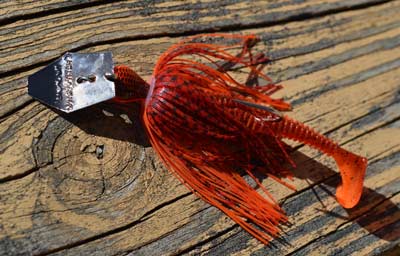
Whether it’s the relatively cold water, increasing aggressiveness, or favored cover and structure, vibrating jigs and prespawn bass go together like peanut butter and jelly. Their sweet spot is heavy cover, where bass retreat during cold fronts and escape escalating fishing pressure. Photo by Pete M. Anderson Late winter and early spring usually bring plenty of rain. And its associated runoff muddies the water, especially creeks and other shallow stretches, exactly where prespawn bass are headed. Vibrating jigs cut through that turbidity with plenty of action, giving bass a clear meal.
Rig your vibrating jig with a trailer. It should be bulky and create some action. You want to keep a compact offering. Use water color to dictate your color choice. Black and red are perfect for muddy water; choose natural hues like green pumpkin for clear water. Split the difference in stained water using a green pumpkin pattern that sports a few strands of blue, orange, or chartreuse.
Vibrating jigs, which will catch bass that only follow spinnerbaits, are built for fishing thick cover. Try them on these spots:
- Flats: Bass gravitate here on sunny days, especially where submerged brush and laydowns are available. Cast to the thickest parts of the cover when water is still cold, 55 degrees and below.
- Boat docks: With its shimmy and compact profile, these lures represent panfish, a top food for bass swimming on these spots. Concentrate where cover, such as brush or rock, meets the dock.
- Aquatic vegetation: Vibrating jigs easily slip through rising lily pads and submerged aquatic vegetation, which are gathering spots for prespawn bass. Don’t be afraid to bump your lure into the stalks.
Final tip: The blade’s water resistance will scream for a slow retrieve, but speed is a trigger with these lures, especially in clear water. So, choose a reel with a medium gear ratio, such as 6.3:1, instead of 7:1 or more. It’ll take more handle turns per cast to generate speed, but its power will make it easy to overcome the resistance.
Soft-Plastic Swimbait
Early prespawn bass want a big meal, and a soft-plastic swimbait delivers. Rig it Texas style, and you can fish it through any cover, from the depths to the shallows, by simply adjusting its weight.
- Examples: Megabass Magdraft, Keitech Swing Impact FAT, Berkley Powerbait Hollow Belly
- Size: 4 inches to 6 inches
- Colors: Natural hues, such as watermelon, pumpkin, smoke, or baitfish patterns such as pearl or glitter
Image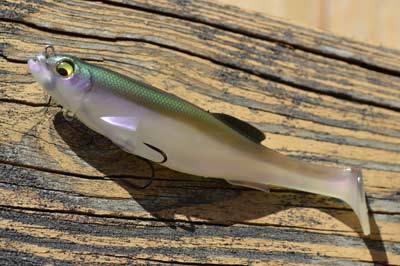
Big soft-plastic swimbaits cater to prespawn bass’ big appetites. Use a Texas rig or hidden treble to serve them in whatever cover or structure you encounter. Photo by Pete M. Anderson Early prespawn bass are aggressive and hungry, needing energy for the upcoming springtime rituals. They aren't bashful about running down a big meal. So, big lures trip their trigger. That’s what makes large swimbaits the perfect choice.
One of a large swimbait's most potent traits is its tail's ability to create plenty of action, even at slow speeds. That draws bass in from distances, through stained water, and out of heavy cover, all everyday situations while fishing early in prespawn.
When bass are in deep water, and the cover is sparse, you can rig a swimbait on a jig head and open hook. But as the depth decreases and cover increases, go to a Texas rig or hidden treble. It’ll slip through spots that stop other lures, including:
- Submerged aquatic vegetation: Texas-rigged swimbaits are at home in this classic prespawn cover, where their thumping tail attracts bass. Slow roll them, ticking the tops of the plants.
- Shallow brush: Swimbaits in shallow water are a subtle alternative to spinnerbaits or vibrating jigs. Fish them similarly, ensuring each cast crosses as many ambush points as possible.
- Boat docks: Some bass spawn around these manmade structures, but most use them as jumping-off points for nearby shallow coves. Flat-sided swimbaits can be skipped underneath horizontal sections.
Final tip: These baits demand large heavy-wire hooks, which require ample effort to cut through plenty of plastic before lodging in a bass. So, your rod needs enough power — heavy or extra heavy — and a fast action. The latter ensures you get into the rod’s backbone quickly, especially when using no-stretch braided line.
BassResource may receive a portion of revenues if you make a purchase using a link above.


